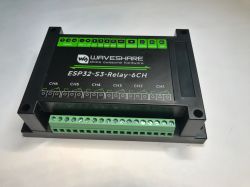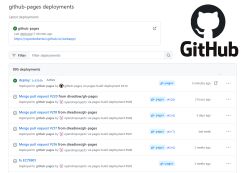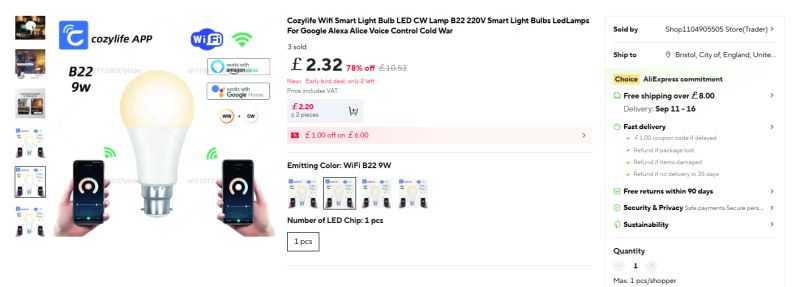Welcome.
I'm basically completely in the dark - I'm piecing together what I can find around the web and something works. I would like to modify the following program so that I can add specific sensors with their addresses and display their reading under a specific name - e.g. Temp.Salon: .... I have the sensor addresses because the attached program displays each sensor in the monitor. I plan to display the readings from specific sensors under a defined name sequentially on a 64x48 OLED - but I hope I can manage that.
In general, I would throw away the detection of what chip is in the sensor, I have all DS18B20 with address 28 ...
Another issue after dealing with the above, how to read specific sensors in Blynk - at the moment I can read a sensor from any board by just selecting the board. How about several on 1 board?
Ps. I use a delay so I don't send temperatures up my sleeve - probably not a good solution, by the way it determines the response time in communication between D1 and Blynk - so what I send is also realised with such a delay - how to handle it, probably with some kind of counter?
In the suggestions, please comment on each line, it makes it easier to grasp and understand.
Programme:
#define BLYNK_PRINT Serial // Enables Serial Monitor
#include <SPI.h>
#include <ESP8266WiFi.h>
#include <BlynkSimpleEsp8266.h>
#include <OneWire.h>
OneWire ds(D4); // on wemos pin D2 (a 4.7K resistor is necessary) make sure you change this from the original pin 10 to an unused pin.
char auth[] = "blah blah blah"; // Thermometer test Auth Token here. (see Step 3 above)
// char auth[] = "blah blah blah"; // Thermometer2 Put your Auth Token here. (see Step 3 above)
// char auth[] = "blah blah blah"; // D1 Mini Pro Put your Auth Token here. (see Step 3 above)
// Your WiFi credentials.
// Set password to "" for open networks.
char ssid[] = "bla bla bla";
char pass[] = "blah blah blah";
void setup()
{
// Debug console
Serial.begin(9600);
Blynk.begin(auth, ssid, pass);
}
void loop()
{
Blynk.run(); // All the Blynk Magic happens here....
// You can inject your own code or combine it with other sketches.
// Check other examples on how to communicate with Blynk. Remember
// to avoid delay() function!
delay(10000); // this should not be here .
.
byte i;
byte present = 0;
byte type_s;
byte data[12];
byte addr[8];
float celsius, fahrenheit;
if ( !ds.search(addr)) {
Serial.println("No more addresses.");
Serial.println(" ========================================== ");
Serial.println();
ds.reset_search();
delay(250);
return;
}
Serial.print("ROM =");
for ( i = 0; i < 8; i++) {
Serial.write(' ');
Serial.print(addr[i], HEX);
}
if (OneWire::crc8(addr, 7) != addr[7]) {
Serial.println("CRC is not valid!");
return;
}
Serial.println();
// the first ROM byte indicates which chip
switch (addr[0]) {
case 0x28:
Serial.println(" Chip = DS18B20");
type_s = 0;
break;
default:
Serial.println("Device is not a DS18x20 family device.");
return;
}
ds.reset();
ds.select(addr);
ds.write(0x44, 1); // start conversion, with parasite power on at the end
delay(1000); // maybe 750ms is enough, maybe not
// we might do a ds.depower() here, but the reset will take care of it.
present = ds.reset();
ds.select(addr);
ds.write(0xBE); // Read Scratchpad
Serial.print(" Data = ");
Serial.print(present, HEX);
Serial.print(" ");
for ( i = 0; i < 9; i++) { // we need 9 bytes
data[i] = ds.read();
Serial.print(data[i], HEX);
Serial.print(" ");
}
Serial.print(" CRC=");
Serial.print(OneWire::crc8(data, 8), HEX);
Serial.println();
// Convert the data to actual temperature
// because the result is a 16 bit signed integer, it should
// be stored to an "int16_t" type, which is always 16 bits
// even when compiled on a 32 bit processor.
int16_t raw = (data[1] << 8) | data[0];
if (type_s) {
raw = raw << 3; // 9 bit resolution default
if (data[7] == 0x20) {
// "count remain" gives full 12 bit resolution
raw = (raw & 0xFFF0) + 12 - data[6];
}
} else {
byte cfg = (data[4] & 0x60);
// at lower res, the low bits are undefined, so let's zero them
if (cfg == 0x00) raw = raw & ~7; // 9 bit resolution, 93.75 ms
else if (cfg == 0x20) raw = raw & ~3; // 10 bit res, 187.5 ms
else if (cfg == 0x40) raw = raw & ~1; // 11 bit res, 375 ms
//// default is 12 bit resolution, 750 ms conversion time
}
celsius = (float)raw / 16.0;
fahrenheit = celsius * 1.8 + 32.0;
Serial.print(" Temperature = ");
Serial.print(celsius);
Serial.print(" °C, ");
Serial.print(fahrenheit);
Serial.println(" Fahrenheit");
Blynk.virtualWrite(V6, celsius);
I would very much appreciate help with the changes with full explanations of what/how/why.
Regards
I'm basically completely in the dark - I'm piecing together what I can find around the web and something works. I would like to modify the following program so that I can add specific sensors with their addresses and display their reading under a specific name - e.g. Temp.Salon: .... I have the sensor addresses because the attached program displays each sensor in the monitor. I plan to display the readings from specific sensors under a defined name sequentially on a 64x48 OLED - but I hope I can manage that.
In general, I would throw away the detection of what chip is in the sensor, I have all DS18B20 with address 28 ...
Another issue after dealing with the above, how to read specific sensors in Blynk - at the moment I can read a sensor from any board by just selecting the board. How about several on 1 board?
Ps. I use a delay so I don't send temperatures up my sleeve - probably not a good solution, by the way it determines the response time in communication between D1 and Blynk - so what I send is also realised with such a delay - how to handle it, probably with some kind of counter?
In the suggestions, please comment on each line, it makes it easier to grasp and understand.
Programme:
#define BLYNK_PRINT Serial // Enables Serial Monitor
#include <SPI.h>
#include <ESP8266WiFi.h>
#include <BlynkSimpleEsp8266.h>
#include <OneWire.h>
OneWire ds(D4); // on wemos pin D2 (a 4.7K resistor is necessary) make sure you change this from the original pin 10 to an unused pin.
char auth[] = "blah blah blah"; // Thermometer test Auth Token here. (see Step 3 above)
// char auth[] = "blah blah blah"; // Thermometer2 Put your Auth Token here. (see Step 3 above)
// char auth[] = "blah blah blah"; // D1 Mini Pro Put your Auth Token here. (see Step 3 above)
// Your WiFi credentials.
// Set password to "" for open networks.
char ssid[] = "bla bla bla";
char pass[] = "blah blah blah";
void setup()
{
// Debug console
Serial.begin(9600);
Blynk.begin(auth, ssid, pass);
}
void loop()
{
Blynk.run(); // All the Blynk Magic happens here....
// You can inject your own code or combine it with other sketches.
// Check other examples on how to communicate with Blynk. Remember
// to avoid delay() function!
delay(10000); // this should not be here
byte i;
byte present = 0;
byte type_s;
byte data[12];
byte addr[8];
float celsius, fahrenheit;
if ( !ds.search(addr)) {
Serial.println("No more addresses.");
Serial.println(" ========================================== ");
Serial.println();
ds.reset_search();
delay(250);
return;
}
Serial.print("ROM =");
for ( i = 0; i < 8; i++) {
Serial.write(' ');
Serial.print(addr[i], HEX);
}
if (OneWire::crc8(addr, 7) != addr[7]) {
Serial.println("CRC is not valid!");
return;
}
Serial.println();
// the first ROM byte indicates which chip
switch (addr[0]) {
case 0x28:
Serial.println(" Chip = DS18B20");
type_s = 0;
break;
default:
Serial.println("Device is not a DS18x20 family device.");
return;
}
ds.reset();
ds.select(addr);
ds.write(0x44, 1); // start conversion, with parasite power on at the end
delay(1000); // maybe 750ms is enough, maybe not
// we might do a ds.depower() here, but the reset will take care of it.
present = ds.reset();
ds.select(addr);
ds.write(0xBE); // Read Scratchpad
Serial.print(" Data = ");
Serial.print(present, HEX);
Serial.print(" ");
for ( i = 0; i < 9; i++) { // we need 9 bytes
data[i] = ds.read();
Serial.print(data[i], HEX);
Serial.print(" ");
}
Serial.print(" CRC=");
Serial.print(OneWire::crc8(data, 8), HEX);
Serial.println();
// Convert the data to actual temperature
// because the result is a 16 bit signed integer, it should
// be stored to an "int16_t" type, which is always 16 bits
// even when compiled on a 32 bit processor.
int16_t raw = (data[1] << 8) | data[0];
if (type_s) {
raw = raw << 3; // 9 bit resolution default
if (data[7] == 0x20) {
// "count remain" gives full 12 bit resolution
raw = (raw & 0xFFF0) + 12 - data[6];
}
} else {
byte cfg = (data[4] & 0x60);
// at lower res, the low bits are undefined, so let's zero them
if (cfg == 0x00) raw = raw & ~7; // 9 bit resolution, 93.75 ms
else if (cfg == 0x20) raw = raw & ~3; // 10 bit res, 187.5 ms
else if (cfg == 0x40) raw = raw & ~1; // 11 bit res, 375 ms
//// default is 12 bit resolution, 750 ms conversion time
}
celsius = (float)raw / 16.0;
fahrenheit = celsius * 1.8 + 32.0;
Serial.print(" Temperature = ");
Serial.print(celsius);
Serial.print(" °C, ");
Serial.print(fahrenheit);
Serial.println(" Fahrenheit");
Blynk.virtualWrite(V6, celsius);
I would very much appreciate help with the changes with full explanations of what/how/why.
Regards





